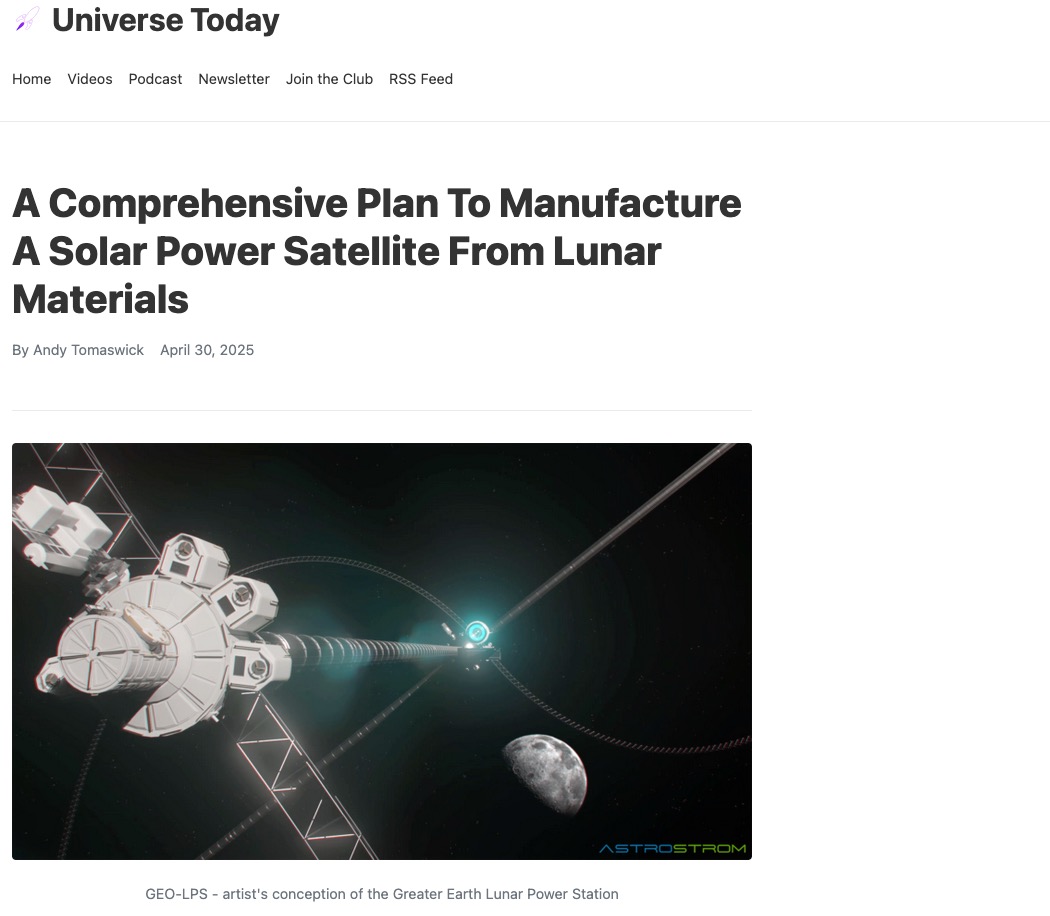A Comprehensive Plan To Manufacture A Solar Power Satellite From Lunar Materials
Space-based solar power (SBSP) has long been the dream of many space enthusiasts and energy economists. However, the reality of economic constraints has long left any practice projects on the ground. There has been plenty of discussion about how to lower the cost of entry to build the kind of space-based solar power satellite described by John Mankins in his books and articles. However, even with the advent of lower costs to orbit thanks to reusable rockets, the economic case for SBSP is still not great simply due to the sheer amount of mass required to get into orbit. Unless we get that mass from somewhere else, with a smaller gravity well. Astrostrom, which means something like “Star current” in German, is an organization based in Switzerland that hopes to make space-based solar power a reality.
Astrostrom’s plan to create a viable space-based solar power satellite has three main features. First, the materials needed for manufacturing on the Moon will be mined. Second, those materials will be moved to a manufacturing/assembly station in space (which could include the use of a lunar space elevator). Third, the necessary parts will be mass-produced, and then a finished solar power satellite will be moved into position in Earth orbit.
Getting the raw material from the Moon to construct a solar power satellite isn’t a new idea – it’s been around since at least the 1970s when Gerard O’Neill (famous for his “O’Neill cylinders”) and others suggested that doing so could dramatically reduce the cost of building such a system. Since then, there has been some progress on that goal, including Blue Origin making solar panels out of lunar regolith simulant and developing monograin layer photovoltaic cells that don’t require heavy, cumbersome wafer technology.

Fraser discusses beaming solar power in space with Dr. Stephen Sweeney
YouTube: https://www.youtube.com/watch?v=XDWTPGPoqko
However, plenty of technical challenges still exist in this approach, including getting the necessary equipment to the Moon in the first place. Various solutions have been proposed, such as having a self-replicated factory set up to process moon regolith, create more of itself, and then keep growing exponentially, but that remains far out of the realm of potential solutions at this point. At the very least, it would likely require human intervention when things went wrong, which would require a whole infrastructure to have a consistent human presence on the Moon in the first place.
Once the resources have been collected, they must be refined and sent to a manufacturing site at the Earth-Moon L1 Lagrange point (directly between the Earth and the Moon). Three different methods are common when discussing this mass transfer – the first is to refine rocket fuel on the Moon itself and use that to power rockets back into orbit, containing the cargo. Second is a massive rail gun that can accelerate inert boxes of material to absurd speeds and literally shoot them into orbit. Third, and the one that Astrostrom seems to favor, is the idea of a Lunar Space Elevator (LSE). To put it mildly, the physics behind a space elevator on Earth is complex. We don’t yet know of any material that is capable of withstanding the forces it would require, at least without active support. However, material that is already regularly manufactured, such as Nylon, would be used to create a Lunar one for the L1 point, which is where the manufacturing system would be. You’d have to ship enough Nylon to the lunar surface to build it – or build it there to begin with.
Once the materials are in space, an orbiting manufacturing center could build almost everything needed for a space-based solar power satellite. This would include a massive amount of the solar panels themselves. However, it would also include the structural components, electronics, and control systems required to handle large amounts of power creation and then successfully beam it back to Earth with little to no power loss. In their description of the plan, Astrostrom mentions a concept called “Butterfly” that integrates the necessary antennas into a V-shaped solar array that is then configured into a giant helix. An estimate of the first system would be 23MW, while future systems could reach up to 1GW.

Fraser discusses the technology to print solar panels in space.
YouTube: https://www.youtube.com/watch?v=qleLIIGJ_xA&t=3s
Ultimately, that scalability is one of the most attractive features of Astrostrom’s plan. Yes, getting all the different systems operating and coordinating together would take a heavy lift. But once that is done, scaling massively would be a cake walk, allowing true, almost free solar power that would otherwise be wasted to benefit humanity from space. While it will take a long time to get there – potentially decades if a detailed report from Astrostrom is any indication – unlimited, clean, solar energy that doesn’t depend on the weather or the rotation of a planet sounds like a worthy goal.
Learn More:
Astrostrom – The Astrostrom Approach to SBSP
UT – Building a Solar Power Satellite from Moon Dust
UT – Does Beaming Power in Space Make Sense at the Moon?
UT – Lunar Regolith Could Power a Future Lunar Station






